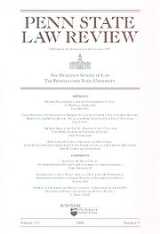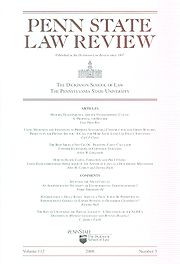
Penn State Law Review
Encyclopedia
The Penn State Law Review is a legal periodical. It was founded in 1897 as The Forum and was later renamed the Dickinson Law Review. When the Dickinson Law School merged with Penn State University in 2003, the name of the periodical was changed to the Penn State Law Review.
The Penn State Law Review is one of four legal periodicals published by the Penn State Law School and one of the oldest law journals in the United States
. The three other Penn State journals are Penn State International Law Review, Penn State Environmental Law Review, and The Yearbook on Arbitration and Mediation. The Review is a general-interest journal that is run entirely by students. As a general-interest journal, the Penn State Law Review publishes in the broad range of legal scholarship and does not limit submissions by any specific topic. The journal publishes four times annually. Generally, each issue includes several legal articles and comments. The articles are written by legal scholars and practitioners, and the comments are written by Penn State law students. Every year, as part of a stringent selection process, the journal evaluates a host of submissions.
 For 2010-11 academic year, Penn State Law Review has revised its admission process. The new admission process has not yet been revealed.
For 2010-11 academic year, Penn State Law Review has revised its admission process. The new admission process has not yet been revealed.
. The Associate Editors are also required to produce a legal comment of publishable quality. Once complete, the student-written comments are reviewed and graded by the Law Review Comments Editors. Subsequently, some of the comments are selected for publication in the journal.
. Following successful completion of their duties as Associate Editors, second-year law review members may choose to run for a position on the Law Review's editorial board. The Penn State Law Review editorial board presently consists of the following positions: Editor-in-Chief, Managing Editor, Executive Articles Editor, Executive Comments Editor, Articles Editor, Comments Editor, Research Editor, and Online Editor. The editorial board comprises the managing body of the journal, and day-to-day law review operations are carried out by the efforts of the editorial board. Third-year non-editorial board members serve as Senior Editors and act, in part, as advisers to the Associate Editors.
The Penn State Law Review is one of four legal periodicals published by the Penn State Law School and one of the oldest law journals in the United States
United States
The United States of America is a federal constitutional republic comprising fifty states and a federal district...
. The three other Penn State journals are Penn State International Law Review, Penn State Environmental Law Review, and The Yearbook on Arbitration and Mediation. The Review is a general-interest journal that is run entirely by students. As a general-interest journal, the Penn State Law Review publishes in the broad range of legal scholarship and does not limit submissions by any specific topic. The journal publishes four times annually. Generally, each issue includes several legal articles and comments. The articles are written by legal scholars and practitioners, and the comments are written by Penn State law students. Every year, as part of a stringent selection process, the journal evaluates a host of submissions.
Admissions

Duties of Associate Editors
The second-year law students participate as Associate Editors of the Law Review. Duties of the Associate Editors include checking sources cited in the articles pending publication to ensure the sources' compliance with the most recent edition of the BluebookBluebook
The Bluebook: A Uniform System of Citation, a style guide, prescribes the most widely used legal citation system in the United States. The Bluebook is compiled by the Harvard Law Review Association, the Columbia Law Review, the University of Pennsylvania Law Review, and the Yale Law Journal....
. The Associate Editors are also required to produce a legal comment of publishable quality. Once complete, the student-written comments are reviewed and graded by the Law Review Comments Editors. Subsequently, some of the comments are selected for publication in the journal.
The Editorial Board
The Penn State Law Review is managed by an editorial boardEditorial board
The editorial board is a group of people, usually at a publication, who dictate the tone and direction the publication's editorial policy will take.- Board makeup :...
. Following successful completion of their duties as Associate Editors, second-year law review members may choose to run for a position on the Law Review's editorial board. The Penn State Law Review editorial board presently consists of the following positions: Editor-in-Chief, Managing Editor, Executive Articles Editor, Executive Comments Editor, Articles Editor, Comments Editor, Research Editor, and Online Editor. The editorial board comprises the managing body of the journal, and day-to-day law review operations are carried out by the efforts of the editorial board. Third-year non-editorial board members serve as Senior Editors and act, in part, as advisers to the Associate Editors.

